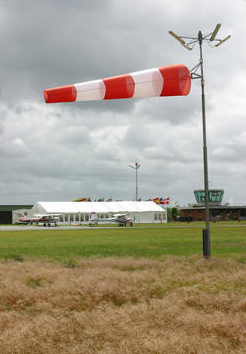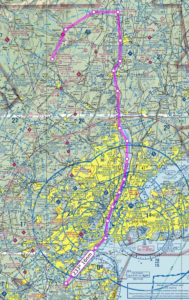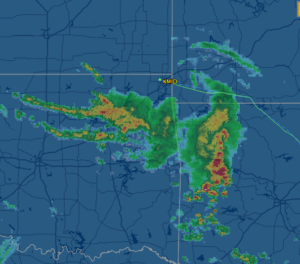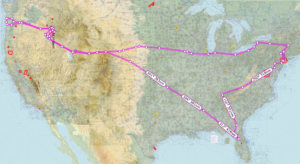I’ve made several long distance cross country trips in my private aircraft. I’d like to share some of the lessons I’ve learned. This is by no means an exhaustive explanation of everything you need to know before taking a long trip. Instead these are some key points I try to keep in mind while planning and flying over long distances in my own airplane.
Know Yourself
It is probably most important to understand your own experience and comfort level as a pilot. I remember my instructor talking about setting personal minimums. I wrote my personal minimums on the inside cover of my log book and I still review them each time I write an entry. Before tackling a long trip this would be a good item to review and keep in mind during the planning phase. I know how much crosswind I can handle when landing my plane. If the crosswind is too high I am going to rethink my choices.
One of the biggest killers of small aircraft pilots is a phenomenon called get-there-itis. In get-there-itis, personal or external pressure clouds the vision and impairs judgment by causing a fixation on the original goal or destination combined with a total disregard for alternative course of action. When you are getting ready to make a long trip check your own ideas about flying these long distances. If you start using words such as “I have to be at this place by this time”, it might be a good time to take a step back and reevaluate your priorities for this trip. Often pilots will develop get-there-itis and far exceed there own personal minimums by flying into conditions they would not normally attempt and find themselves in real trouble.
Know Your Aircraft
I most often fly a 1968 Cherokee 180 D. After so many hours of flying I can tell when something is off just by the way the aircraft feels when I start it or when I am flying. I know pretty well how the plane is going to react to particular flight conditions. Knowing these behaviors of the craft you are planning to fly is important. I would not recommend taking a long trip in a plane I’ve never flown. A better plan would be to get to know the plane on a few short trips and get comfortable with the particular quirks of that craft before ever attempting to make a long cross-country trip.
 Fuel consumption is critical in a cross country flight and it is important to know how much fuel you can carry and how much your craft will burn in flight. I often plan to have more fuel than just the minimums at each landing site. For example, my aircraft has a range of about 500 miles with day VFR reserves of 30 minutes. Ever consider how little fuel 30 minutes represents? In my plane that is about five gallons of fuel or two and half gallons in each tank. The fuel gauges would barely be off the empty mark. I am not willing to take my plane down to that low of fuel. A strong headwind can increase your fuel consumption considerably and leave your fuel tanks bone dry long before reaching your destination. For these reasons I always plan the legs of my flight to leave me with one hour of fuel upon reaching my destination.
Fuel consumption is critical in a cross country flight and it is important to know how much fuel you can carry and how much your craft will burn in flight. I often plan to have more fuel than just the minimums at each landing site. For example, my aircraft has a range of about 500 miles with day VFR reserves of 30 minutes. Ever consider how little fuel 30 minutes represents? In my plane that is about five gallons of fuel or two and half gallons in each tank. The fuel gauges would barely be off the empty mark. I am not willing to take my plane down to that low of fuel. A strong headwind can increase your fuel consumption considerably and leave your fuel tanks bone dry long before reaching your destination. For these reasons I always plan the legs of my flight to leave me with one hour of fuel upon reaching my destination.
Know Your Route
This may seem a bit fundamental but I try to have a really good idea of where I am going to fly.  I take a good amount of time in planning my route, which involves activities such as studying the terrain along my chosen path and making note of any distinctive landmarks or features. I also review approach procedures for my landing sites, and mentally note any alternate or emergency landing sites. I often go on YouTube and look for videos from other pilots that are flying routes and landing at the airports I might use. You would be surprised at how much you can glean from watching a video of someone landing at an airport you might use along your route.
I take a good amount of time in planning my route, which involves activities such as studying the terrain along my chosen path and making note of any distinctive landmarks or features. I also review approach procedures for my landing sites, and mentally note any alternate or emergency landing sites. I often go on YouTube and look for videos from other pilots that are flying routes and landing at the airports I might use. You would be surprised at how much you can glean from watching a video of someone landing at an airport you might use along your route.
Have a Backup Plan or Two or Three
When flying cross-country I try to keep in mind that the trip is not just about getting there, but also about the journey. Although I plan on going to my primary landing site, I also plan a secondary and even a tertiary landing site. This idea ties into knowing yourself. If you keep an attitude of enjoying the journey and not being rigidly committed to a specific destination you can make better decisions about when to choose an alternate landing site.
 Weather conditions can change rapidly and no forecast is perfect. If I see that the conditions ahead in the direction of my primary landing site are not looking safe, I might land sooner or turn on an angle away from my route and away from the weather. When I plan backup sites I often pick one that is before my primary destination and then I also pick one on an angle to secondary. For example if my destination for the day is 400 miles due west I pick an alternate that is 350 miles west and then another that is north or south. This way I have alternates and ways to escape bad weather.
Weather conditions can change rapidly and no forecast is perfect. If I see that the conditions ahead in the direction of my primary landing site are not looking safe, I might land sooner or turn on an angle away from my route and away from the weather. When I plan backup sites I often pick one that is before my primary destination and then I also pick one on an angle to secondary. For example if my destination for the day is 400 miles due west I pick an alternate that is 350 miles west and then another that is north or south. This way I have alternates and ways to escape bad weather.
Know the Weather Patterns
When planning a long cross-country trip, I start obsessing about the weather probably two weeks before. Weather patterns are often cyclic and getting to know how the weather will behave during your time in the air is vital to a safe flight. The official sources such as aviationweather.gov , DUATS and 1800wxbrief.com are essential sources. I also like to use Weather Underground’s interactive maps and detailed forecasts to help get a better picture of the weather along my route. I tend to stay away from the full-time newsy cable weather products as they tend to exaggerate and sensationalize the weather and in my humble opinion often give inflated and emotional forecasts.
So there you go some tips on planning and making a safe cross country flight. I hope something I shared here helps you have an enjoyable and safe trip.

